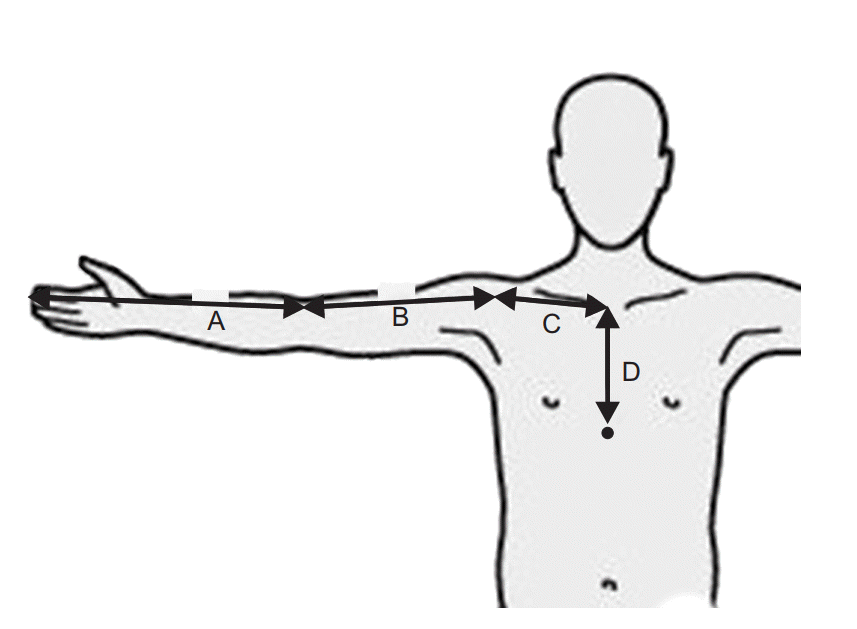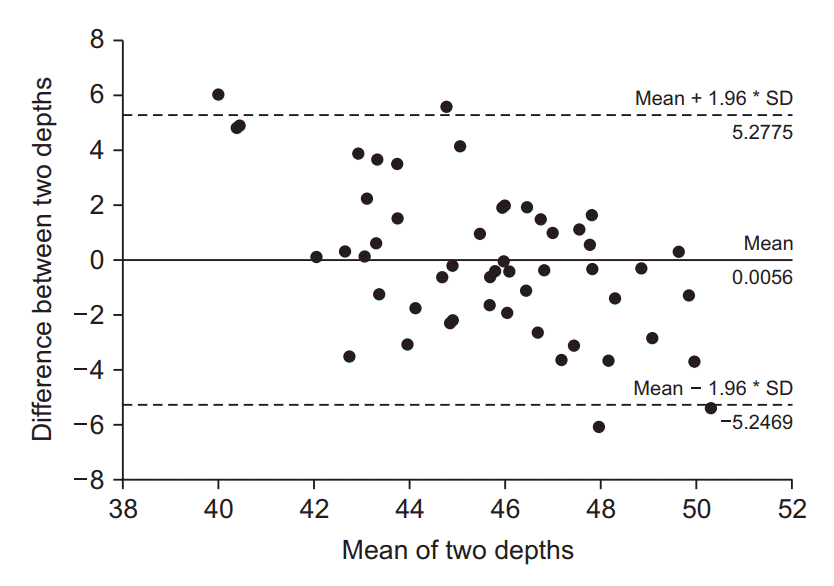1. Periard D, Monney P, Waeber G, Zurkinden C, Mazzolai L, Hayoz D, et al. Randomized controlled trial of peripherally inserted central catheters vs. peripheral catheters for middle duration in-hospital intravenous therapy. J Thromb Haemost. 2008; 6:1281–8.

2. Chopra V, Flanders SA, Saint S. The problem with peripherally inserted central catheters. JAMA. 2012; 308:1527–8.

3. McGee WT, Ackerman BL, Rouben LR, Prasad VM, Bandi V, Mallory DL. Accurate placement of central venous catheters: a prospective, randomized, multicenter trial. Crit Care Med. 1993; 21:1118–23.
4. Ezri T, Weisenberg M, Sessler DI, Berkenstadt H, Elias S, Szmuk P, et al. Correct depth of insertion of right internal jugular central venous catheters based on external landmarks: avoiding the right atrium. J Cardiothorac Vasc Anesth. 2007; 21:497–501.

5. Huh J, Yoo SY, Ro YJ, Min SW, Bahk JH, Kim JS. Survey of central venous catheter depth using the carina as a radiologic landmark in ICU patients. Korean J Anesthesiol. 2005; 49:376–80.

6. Na HS, Kim JT, Kim HS, Bahk JH, Kim CS, Kim SD. Practical anatomic landmarks for determining the insertion depth of central venous catheter in paediatric patients. Br J Anaesth. 2009; 102:820–3.

7. Kim H, Jeong CH, Byon HJ, Shin HK, Yun TJ, Lee JH, et al. Predicting the optimal depth of left-sided central venous catheters in children. Anaesthesia. 2013; 68:1033–7.

8. Jung CW, Lim YJ, Kim SD. Estimation of the optimal depth of subclavian catheterizations in pediatric patients. Korean J Anesthesiol. 1999; 37:426–30.

9. Dane TE, King EG. Fatal cardiac tamponade and other mechanical complications of central venous catheters. Br J Surg. 1975; 62:6–10.

10. Iberti TJ, Katz LB, Reiner MA, Brownie T, Kwun KB. Hydrothorax as a late complication of central venous indwelling catheters. Surgery. 1983; 94:842–6.
11. Dailey RH. Late vascular perforations by CVP catheter tips. J Emerg Med. 1988; 6:137–40.

12. Krauss D, Schmidt GA. Cardiac tamponade and contralateral hemothorax after subclavian vein catheterization. Chest. 1991; 99:517–8.

13. Duntley P, Siever J, Korwes ML, Harpel K, Heffner JE. Vascular erosion by central venous catheters. Clinical features and outcome. Chest. 1992; 101:1633–8.
14. Cardella JF, Cardella K, Bacci N, Fox PS, Post JH. Cumulative experience with 1,273 peripherally inserted central catheters at a single institution. J Vasc Interv Radiol. 1996; 7:5–13.

15. Neuman ML, Murphy BD, Rosen MP. Bedside placement of peripherally inserted central catheters: a cost-effectiveness analysis. Radiology. 1998; 206:423–8.

16. Schuster M, Nave H, Piepenbrock S, Pabst R, Panning B. The carina as a landmark in central venous catheter placement. Br J Anaesth. 2000; 85:192–4.
17. Shin TJ, Yoon SJ, Park C, Kim CS, Kim SD. The optimal depth of central venous catheter by using transesophageal echocardiography for pediatric patients. Korean J Anesthesiol. 2005; 48:S11–4.

18. Venkatesan T, Sen N, Korula PJ, Surendrababu NR, Raj JP, John P, et al. Blind placements of peripherally inserted antecubital central catheters: initial catheter tip position in relation to carina. Br J Anaesth. 2007; 98:83–8.

19. Connolly B, Amaral J, Walsh S, Temple M, Chait P, Stephens D. Influence of arm movement on central tip location of peripherally inserted central catheters (PICCs). Pediatr Radiol. 2006; 36:845–50.

20. Jeon EY, Koh SH, Lee IJ, Ha HI, Park BJ. Useful equation for proper estimate of left side peripherally inserted central venous catheter length in relation to the height. J Vasc Access. 2015; 16:42–6.

21. Andropoulos DB, Bent ST, Skjonsby B, Stayer SA. The optimal length of insertion of central venous catheters for pediatric patients. Anesth Analg. 2001; 93:883–6.






 PDF
PDF Citation
Citation Print
Print




 XML Download
XML Download